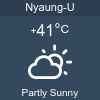Bagan
Bagan Murals
- Details
- Hits: 7319
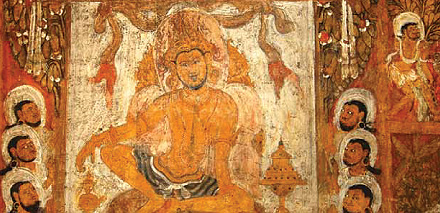 Bagan Murals
Bagan Murals
There are more than 3000 religious buildings still standing in the Bagan historical zone. After almost 1000 years, these monuments still contain more than 200,000 square feet of religious murals.
Most of the remaining murals date to what is commonly referred to as the Bagan era: founded by King Anawrahta in 1044, it spanned the 11th, 12th and 13th centuries. But newer style of murals can also be seen at one or two temples because kings from empires that succeeded the Bagan era remained dedicated to propagating Buddhism, donating religious buildings and organising murals to be painted as a means of both decoration and giving knowledge to people. The meritous deeds of successive leaders can be seen throughout what is without doubt one of the most significant and awe-inspiring archaeological sites in Asia. Of the murals at Bagan, there are five in particular that stand out and span the different eras of Myanmar history. The first is the mural at Gyu Pyaut Gyi Temple in Myinkabar quarter, which was donated by royal price Yazakumar in the Bagan era and covers 4779.9 square feet. The second is Thiho Pone Pagoda, situated in the compound of Sin Phyu Shin Monstery in Bagan Min Nanthu quarter. Donated by King Sin Phyu Shin in the Pinya era, about 500 square feet of the mural remains. Thirdly, there is Taung Bee Pitaka Thike (pitaka thike means library) from the Inwa era in Bagan Taung Bee quarter, of which 308 square feet remains. Hman Si Pagoda of the Nyaung Yan era in Bagan Phwar Saw quarter covers 384 square feet, while last but not least the mural at the Konbaung-era Shwe Kyaung Oo Pagoda in Bagan Taung Bee quarter covers 215 square feet. Murals spanning these five eras can only be seen in the Bagan historical zone, and because they are collected together in one place makes it easier to look back at each era through the murals. Myanmar traditional painting started in the Bagan era and it developed after the arrival of Theravada Buddhism.
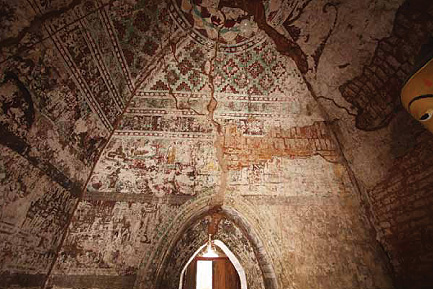
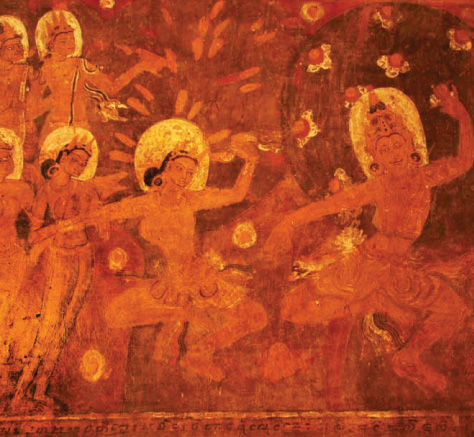
Buddhists originally maintained the pitaga, or scriptures, through word of mouth, but later on they were recorded in literature. There are three pitaga and together they are called pitaga thone pone. The winaya pitaga contains the complete teachings of the Buddha, the thuta pitaga the code of conduct and the abhidhamma pitaga the Buddhist doctrine. The Bagan murals describe stories from pitaga thone pone. A feature of traditional painting through the five eras is the combined use of figure and kanok, a traditional art style that depicts convoluted lotus stems, buds and blossoms. Among the temples in Bagan containing murals, Gu Pyauk Gyi Temple in Myinkabar quarter has rerained almost 5000 square feet of murals. The colours remain almost as vivid as if they were painted yesterday. The temple was donated by royal Prince Yazakumar and he inscribed the donation on stone in four languages: Pyu, Mon, Pali and Myanmar. The stone windows of the pagoda are very beautiful and many of the inside wall are decorated with murals. The paint was applied thickly in a range of colours, including light blue, pink and dark red. My favorite mural is on the walls along the stairway to the stone windows on the southern wall. It depicts Bagan ladies who visited the temple adorned elegantly. One of two dancers who are watched by the group of ladies has eyes that burn with life and it seems like she is almost breathing. For Pinya-era murals, there’s only one place to look and that’s Sin Phyu Shin Monastery, which can be found on the road in Bagan Nanthu before Myauk Phat Min Nanthu village. The monastery is inside two compounds: the outer wall is 800 feet in circumference and the inner wall 400 feet. There are stupas,a monastery,convocation hall and a lake in the compound. Compared to the Baganera style, the murals at Thiho Pone Pagoda in Sin Phyu Shin Monastery are more decorative and they should be considered a herald of the Inwa, Nyaung Yan and Konbaung eras.
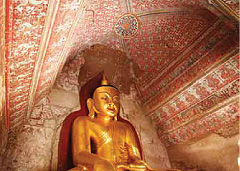

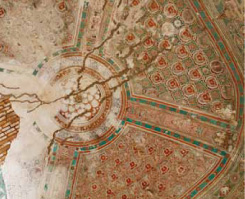

A further difference from the Bagan style is the use of green, brown and red and also thick black lines in the murals. An Inwa-style mural can be seen at Taung Bee Pitaka Thike in Bagan Taung Bee quarter. The art work at the entrance of the pitaka thike, or library, is amazing and more striking because of the use of the contrasting colours red and green. The soldiers of Marnat (a man who tried to get rid of Guatama Buddha) are particularly attractive.

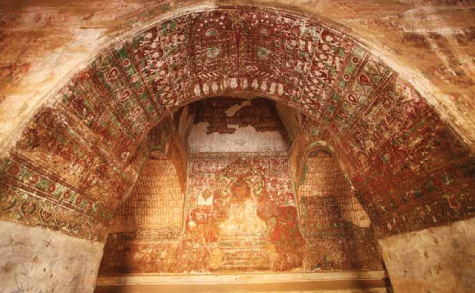
A number of features indicate the mural is from the Inwa era, aside from the text and date: the three-quarter face depiction, big eyes and plump cheek are all unique trademarks of the Inwa period. I imagine very few people would think that Hman Si temple in Bagan Phywar Saw quarter was built during the Nyaung Yan era. The small temple is situated alone in the middle of agricultural fields and does not get much attention from visitors. To get to the entrance, you first have to navigate a large hole dug by fortune hunters. The murals feature heavy use of green and white colours, as well as brown lines and flowery motifs. The paintings on the ceiling remain in their original state, with traditional gods drawn individually. In contrast, many Konbaung-era murals remain in Bagan at temples that are being actively looked after by the archaeological authorities. Shwe Kyaung Oo Pagoda in Taung Bee quarter is but one example of this fine legacy from the last in a rich succession of Myanmar empires, each of which left their mark on the incredible historical zone at Bagan.
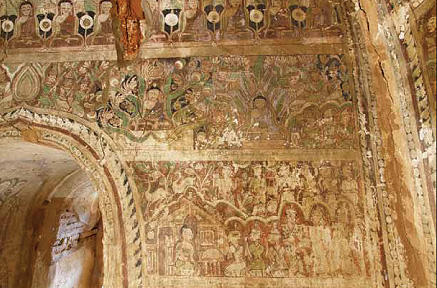
Source : SweSone Yangon Airways Inflight Magazine
Author : Moh Moh Thaw






